Development of Deformation Bands and Deformation Induced Weathering in a Forearc Coal-Bearing Paleogene Fold Belt, Northern Japan
Abstract
1. Introduction
2. Geological Setting
| Age | Group and Formation | Lithology | Thickness (m) | Remarks | |
|---|---|---|---|---|---|
| Late Miocene | Atsunai G. | Shiranuka F. | tuffaceous mudst. | 700–750 | Not exposed in the study area. |
| Atsunai F. | pumice tuff, tuffaceous mudst. | 450–480 | Zircon U-Pb age of c. 7 Ma after H. Ito (Personal communication) | ||
| Chokubetsu F. | tuffaceous mudst, sandst. | 1000–1060 | Not exposed in the study area. | ||
| Late Eocene to Early Oligocene | Onbetsu G. | mudst, sandst. | 290–440 | Not exposed in the study area. | |
| Middle Eocene | Urahoro G. | Shakubetsu F. | sandst. mudst. coal layers | 260–290 | |
| Shitakara F. | sandst, mudst. | 240–270 | |||
| Yubetsu F. Tenneru F., Harutori F., Beppo F. | congromerate, sandst, mudst | 390 | Not exposed in the study area. Zircon U-Pb age of c. 39 Ma in the Tenneru F. after Katagiri et al. (2016) [34] | ||
| Late Cretaceous | Not exposed in the study area. | ||||
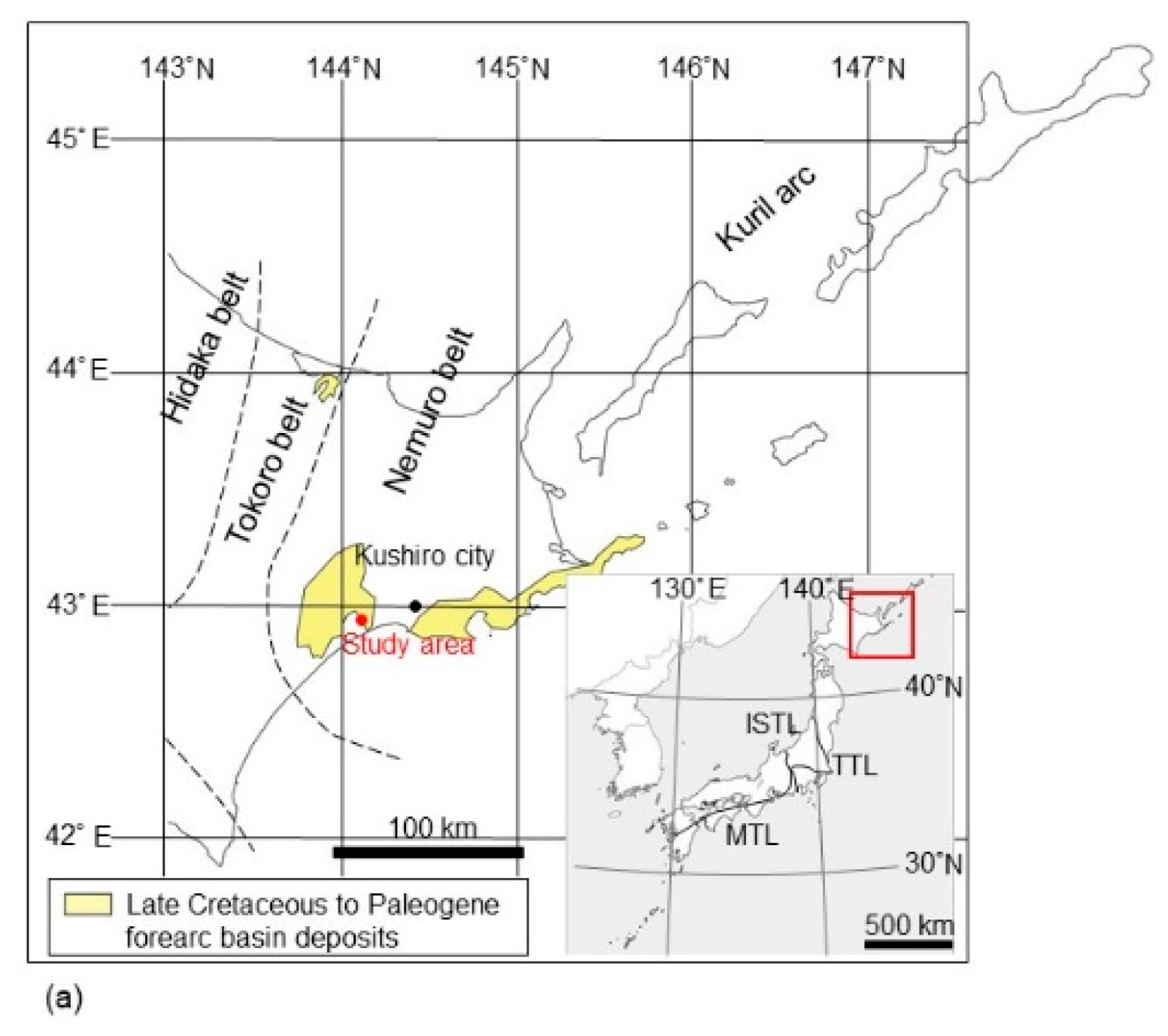
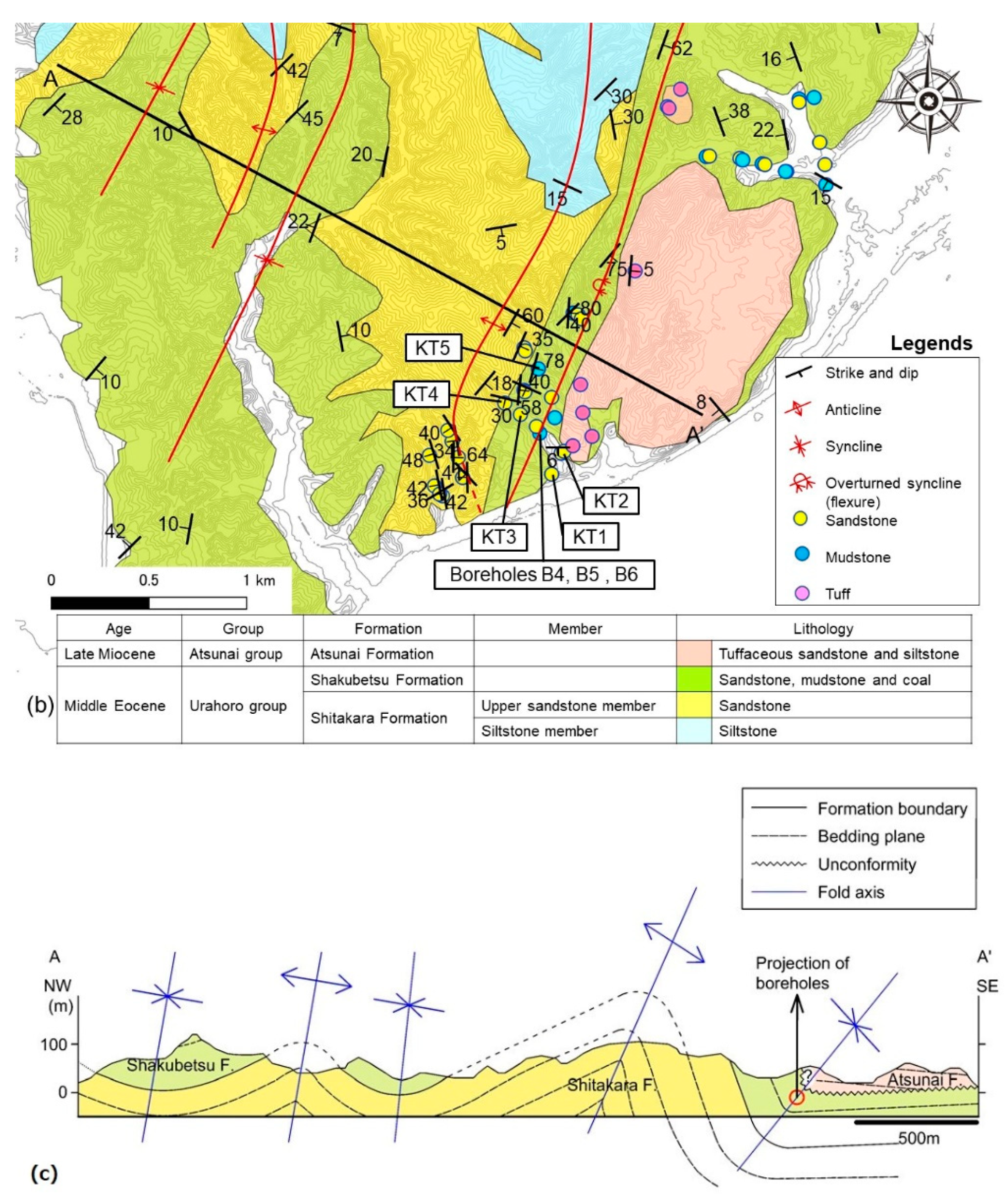
3. Methods
4. Results
4.1. Field Data and Sample Description
4.2. Microstructural Analysis
4.2.1. Microstructure
4.2.2. Image Analysis
4.3. Vitrinite Reflectance
5. Discussion
5.1. Types and Conditions for the Formation of Deformation Bands
5.2. Strain Localization in the Flexure and Implications in Tectonics
5.3. Structural Diagenesis
6. Conclusions
- (1)
- In the study area, the geologic structure of the Eocene Urahoro Group is characterized by a folded belt with a wavelength of 1–2 km. The strata generally dip either east or west at moderate angles. However, there is one flexure structure in the eastern part of the study area consisting of the Shakubetsu Formation, which trends NNE-SSW to NE-SW. The northwestern limb of the flexure very steeply dips SE at 75° to almost vertically, while the southeastern limb dips south at 6° (almost horizontally).
- (2)
- Deformation bands in this area only developed in the Shakubetsu Formation around the flexure, which contains mudstones and coal layers other than sandstones, not in the uppermost unit of the Shitakara Formation, which solely consists of sandstones. Therefore, it could be inferred that strain was localized in the weak Shakubetsu Formation, resulting in the development of flexure and deformation bands with increasing NW-SE trending shortening in the folded belt. This shortening deformation mostly occurred after the deposition of the Atsunai Formation dated c. 7 Ma.
- (3)
- The temperature conditions for the formation of deformation bands were inferred to be c. 50 °C from the vitrinite reflectance values (%RO) of the coal layers (c. 0.5). The deformation bands could have formed at the maximum burial depth, which was inferred to be as much as c. 2.7 km from the thickness of the overlying strata. The depth estimate conforms to the one (1.5–2.5 km) inferred from the inferred temperature conditions, assuming the geothermal gradient of 20 °C in a forearc region and surface temperature of 0–20 °C. The deformation bands were inferred to have originated as phyllosilicate bands, which developed into the cataclastic bands with increasing strain in the Shakubetsu Formation with c. 10 vol.% of phyllosilicate.
- (4)
- In the cataclastic bands, the detrital grains in host sandstones are crushed into sizes less than one-half to one-fifth of the original ones, and the asperities are flaked during the formation of deformation bands. The latter fact could be revealed by a higher circularity of detrital grains in the deformation bands than in the host parts.
- (5)
- Reactive transport or structural diagenesis was significant in the present sandstones with deformation bands, some of which were characterized by the alignment of phyllosilicate (i.e., phyllosilicate bands). Here, the detrital biotite and chlorite grains were fractured along the cleavages and were altered (or weathered) to vermiculite and further to kaolinite. Also, authigenic smectite grew in the pore space created by fracturing in detrital grains. Since the deformation-induced weathering could have significantly reduced the internal friction and permeability of rocks in the study area, the landslide was probably triggered by heavy rainfall in such weathered rocks.
Author Contributions
Funding
Institutional Review Board Statement
Informed Consent Statement
Data Availability Statement
Acknowledgments
Conflicts of Interest
References
- Aydin, A.; Borja, R.I.; Eichhubl, P. Geological and mathematical framework for failure modes in granular rock. J. Struct. Geol. 2006, 28, 83–98. [Google Scholar] [CrossRef]
- Fossen, H.; Schultz, R.A.; Shipton, Z.K.; Mair, K. Deformation bands in sandstone: A review. J. Geol. Soc. 2007, 164, 755–769. [Google Scholar] [CrossRef]
- Fossen, H.; Soliva, R.; Ballas, G.; Trzaskos, B.; Cavalcante, C.; Schultz, R.A. A Review of Deformation Bands in Reservoir Sandstones: Geometries, Mechanisms and Distribution; Geological Society of London Publications: London, UK, 2017; Volume 459, pp. 9–33. [Google Scholar]
- Ballas, G.; Soliva, R.; Benedicto, A.; Sizun, J.P. Control of tectonic setting and large-scale faults on the basin-scale distribution of deformation bands in porous sandstone (Provence, France). Mar. Petrol. Geol. 2014, 55, 142–159. [Google Scholar] [CrossRef]
- Liu, Z.; Sun, Y. Characteristics and formation process of contractional deformation bands in oil-bearing sandstones in the hinge of a fold: A case study of the Youshashan anticline, western Qaidam Basin, China. J. Petrol. Sci. Eng. 2020, 189, 106994. [Google Scholar] [CrossRef]
- Soliva, R.; Schultz, R.A.; Ballas, G.; Taboada, A.; Wibberley, C.; Saillet, E.; Benedicto, A. A model of strain localization in porous sandstone as a function of tectonic setting, burial and material properties; new insight from Provence (southern France). J. Struct. Geol. 2013, 49, 50–63. [Google Scholar] [CrossRef]
- Zuluaga, L.F.; Fossen, H.; Rotevatn, A. Progressive evolution of deformation band populations during Laramide fault-propagation folding: Navajo Sandstone, San Rafael monocline, Utah, USA. J. Struct. Geol. 2014, 68, 66–81. [Google Scholar] [CrossRef]
- Gambino, S.; Fazio, E.; Maniscalco, R.; Punturo, R.; Lanzafame, G.; Barreca, G.; Butler, R.W.H. Fold-related deformation bands in a weakly buried sandstone reservoir analogue: A multi-disciplinary case study from the Numidian (Miocene) of Sicily (Italy). J. Struct. Geol. 2019, 118, 150–164. [Google Scholar] [CrossRef]
- Braathen, A.; Petrie, E.; Nystuen, T.; Sundal, A.; Skurtveit, E.; Zuchuat, V.; Gutierrez, M.; Midtkandal, I. Interaction of deformation bands and fractures during progressive strain in monocline—San Rafael Swell, Central Utah, USA. J. Struct. Geol. 2020, 141, 104219. [Google Scholar] [CrossRef]
- Childs, C.; Manzocchi, T.; Walsh, J.J.; Bonson, C.G.; Nicol, A.; Schöpfer, M.P.J. A geometric model of fault zone and fault rock thickness variations. J. Struct. Geol. 2009, 31, 117–127. [Google Scholar] [CrossRef]
- Mitchell, T.M.; Faulkner, D.R. The nature and origin of off-fault damage surrounding strike-slip fault zones with a wide range of displacements: A field study from the Atacama fault system, northern Chile. J. Struct. Geol. 2009, 31, 802–816. [Google Scholar] [CrossRef]
- Choi, J.-H.; Edwards, P.; Ko, K.; Kim, Y.-S. Definition and classification of fault damage zones: A review and a new methodological approach. Earth Sci. Rev. 2016, 152, 70–87. [Google Scholar] [CrossRef]
- Schultz, R.A.; Siddharthan, R.A. general framework for the occurrence and faulting of deformation bands in porous granular rocks. Tectonophysics 2005, 411, 1–18. [Google Scholar] [CrossRef]
- MacQuarrie, K.T.B.; Mayer, K.U. Reactive transport modeling in fractured rock: A state-of-the-science review. Earth Sci. Rev. 2005, 72, 189–227. [Google Scholar] [CrossRef]
- Kaneko, Y.; Takeshita, T.; Watanabe, Y.; Shigematsu, N.; Fujimoto, K.-I. Alteration reaction and mass transfer via fluids with progress of fracturing along the Median Tectonic Line, Mie Prefecture, Southwest Japan. In Evolutionary Models of Convergent Margins—Origin of Their Diversity; Itoh, Y., Ed.; InTechOpen: London, UK, 2017; pp. 121–142. [Google Scholar]
- Liping, Q.; Huang, A.; Wang Zhechao, W.; Wenyuan Gao, W.; Liua, J. Alteration of minerals and temporal evolution of solution in reactive flow through granitic rock fractures. Int. J. Rock Mech. Min. Sci. 2019, 123, 104105. [Google Scholar] [CrossRef]
- Moore, O.W.; Buss, H.L.; Dosseto, A. Incipient chemical weathering at bedrock fracture interfaces in a tropical critical zone system, Puerto Rico. Geoch. Cosmoch. Acta 2019, 252, 61–87. [Google Scholar] [CrossRef]
- Laubach, S.E.; Eichhubl, P.; Hilgers, C.; Lander, R.H. Structural diagenesis. J. Struct. Geol. 2010, 32, 1866–1872. [Google Scholar] [CrossRef]
- Rodrigues, R.S.; Alves da Silva, F.C.; Córdoba, V.C. Evolution of deformation bands, insights from structural diagenesis. J. Struct. Geol. 2021, 143, 104257. [Google Scholar] [CrossRef]
- Kristensen, T.B.; Rotevatn, A.; Peacock, D.C.P.; Henstra, G.A.; Midtkandal, I.; Grundvåg, S.-A. Structure and flow properties of syn-rift border faults: The interplay between fault damage and fault-related chemical alteration (Dombjerg Fault, Wollaston Forland, NE Greenland). J. Struct. Geol. 2016, 92, 99–115. [Google Scholar] [CrossRef]
- Salomon, E.; Rotevatn, A.; Kristensen, T.B.; Grundvåg, S.-A.; Henstra, G.A.; Meckler, A.N.; Albert, R.; Gerdes, A. Fault-controlled fluid circulation and diagenesis along basin-bounding fault systems in rifts—Insights from the East Greenland rift system. Solid Earth 2020, 11, 1987–2013. [Google Scholar] [CrossRef]
- Salomon, E.; Rotevatn, A.; Kristensen, T.B.; Grundvåg, S.-A.; Henstra, G.A. Microstructure and fluid flow in the vicinity of basin bounding faults in rifts—The Dombjerg Fault, NE Greenland rift system. J. Struct. Geol. 2021, 153, 104463. [Google Scholar] [CrossRef]
- Lommatzsch, M.; Exner, U.; Gier, S.; Grasemann, B. Dilatant shear band formation and diagenesis in calcareous, arkosic sandstones, Vienna Basin (Austria). Mar. Petrol. Geol. 2015, 62, 144–160. [Google Scholar] [CrossRef]
- Collettini, C. The mechanical paradox of low-angle normal faults: Current understanding and open questions. Tectonophysics 2011, 510, 253–268. [Google Scholar] [CrossRef]
- Behnsen, J.; Faulkner, D.R. Permeability and frictional strength of cation-exchanged montmorillonite. J. Geophys. Res. 2013, 118, 2788–2798. [Google Scholar] [CrossRef]
- Regmi, A.D.; Yoshida, K.; Dhital, M.R.; Devkota, K. Effect of rock weathering, clay mineralogy,and geological structures in the formation of large landslide, a case study from Dumre Besei landslide, Lesser Himalaya Nepal. Landslides 2013, 10, 1–13. [Google Scholar] [CrossRef]
- Fujii, K.; Yonetani, H.; Sogabe, M.; Sasaki, M.; Higashide, N. Coal petrological studies of the sub-bituminous coal in the Kushiro Coal Field, Hokkaido, Japan -As basic data for oil exploration off Kushiro. J. Japan Assoc. Petrol. Tech. 1979, 44, 20–29. [Google Scholar] [CrossRef]
- Sasa, Y. The tertiary stratigraphy in the Kushiro coal field and previous views. J. Hokkaido Coal Mining Assoc. 1940, 308, 1–24, (In Japanese with English abstract). [Google Scholar]
- Matsui, M. Sedimentological study of the Paleogene basin of Kushiro in Hokkaido, Japan. J. Fac. Sci. Hokkaido Univ. Ser. IV 1962, 11, 431–480. [Google Scholar]
- Tanai, T. Explanatory text of the Geological Map of Japan, Scale 1:50,000, Onbetsu (Kushiro-45). Hokkaido Dev. Agency. 1957, 52p. (In Japanese with English abstract). Available online: https://www.gsj.jp/data/50KGM/PDF/GSJ_MAP_G050_02045_1957_D.pdf (accessed on 21 August 2022).
- Oda, Y.; Nemoto, T.; Uemura, T. Explanatory text of the Geological Map of Japan, Scale 1:50,000, Tokomuro (Kushiro-44). Hokkaido Dev. Agency. 1959, 54p. (In Japanese with English abstract). Available online: https://www.gsj.jp/data/50KGM/PDF/GSJ_MAP_G050_02044_1959_D.pdf (accessed on 21 August 2022).
- Kaiho, K. Paleogene Foraminifera from Hokkaido, Japan. Part 1: Lithostratigraphy and biostratigraphy including description of new species. Sci. Rep. Tohoku Univ. Sec. Ser. Geol. 1984, 54, 95–139. [Google Scholar]
- Kaiho, K. Paleogene Foraminifera from Hokkaido, Japan. Part 2: Correlation of the Paleogene System in Hokkaido and systematic paleontology. Sci. Rep. Tohoku Univ. Sec. Ser. Geol. 1984, 55, 1–74. [Google Scholar]
- Katagiri, T.; Naruse, H.; Hirata, T.; Hattori, K. U–Pb age of the tuff bed in the Urahoro Group, eastern Hokkaido, northern Japan. J. Geol. Soc. Jpn. 2016, 122, 495–503, (In Japanese with English abstract). [Google Scholar] [CrossRef][Green Version]
- Shibata, K.; Tanai, T. K-Ar ages of Tertiary volcanic rocks in Hokkaido. In Recent Progress in the Neogene Biostratigraphy of Hokkaido; Tanai, T., Ed.; Sapporo, Japan, 1982; pp. 75–80, (In Japanese with English abstract). [Google Scholar]
- Tanai, T.; Yamaguchi, S. Explanatory text of the Geological Map of Japan, Scale 1:50,000, Urahoro (Kushiro-54). Hokkaido Dev. Agency. 1965, 46p. (In Japanese with English abstract). Available online: https://www.gsj.jp/data/50KGM/PDF/GSJ_MAP_G050_02054_1965_D.pdf (accessed on 21 August 2022).
- Suzuki, T. Explanatory text of the Geological Map of Japan, Scale 1:50,000, Shiranuka (Kushiro-43). Hokkaido Dev. Agency. 1958, 46p. Available online: https://www.gsj.jp/data/50KGM/PDF/GSJ_MAP_G050_02046_1958_D.pdf (accessed on 21 August 2022). (In Japanese with English abstract).
- Akiba, F.; Ichinoseki, T. The Neogene Micro- and Chronostratigraphies in Hokkaido-Special Reference to those of the Southwestern Part of the Kushiro Coal Field Area, Eastern Hokkaido, Japan. J. Jpn. Associ. Petrol. Tech. 1983, 48, 48–61. [Google Scholar]
- Kimura, G. Oblique subduction and collision: Forearc tectonics of the Kuril arc. Geology 1986, 14, 404–407. [Google Scholar] [CrossRef]
- Katagiri, T.; Naruse, H.; Ishikawa, N.; Hirata, T. Collisional bending of the western Paleo-Kuril Arc deduced from paleomagnetic analysis and U–Pb age determination. Isl. Arc 2019, 29, e12329. [Google Scholar] [CrossRef]
- Tada, R.; Iijima, A. Stratigraphy and geology of the Neogene Atsunai Group of the Atsunai and Urahoro areas in southeastern Hokkado, Northwest Japan. J. Geol. Soc. Jpn. 1986, 92, 31–45. [Google Scholar] [CrossRef][Green Version]
- The GIMP Document Team. GNU Image Manipulation Program User Manual. 2020. Available online: https://docs.gimp.org/2.10/en/ (accessed on 21 August 2022).
- Abramoff, M.D.; Magelhaes, P.J.; Ram, S.J. Image Processing with ImageJ. Biophotonics Int. 2004, 11, 36–42. [Google Scholar]
- Pizzati, M.; Balsamo, F.; Storti, F. Displacement-dependent microstructural and petrophysical properties of deformation bands and gouges in poorly lithified sandstone deformed at shallow burial depth (Crotone Basin, Italy). J. Struct. Geol. 2020, 137, 104069. [Google Scholar] [CrossRef]
- Sibson, R.H. Fault rocks and fault mechanisms. J. Geol. Soc. London 1977, 133, 191–213. [Google Scholar] [CrossRef]
- Woodcock, N.H.; Mort, K. Classification of fault breccias and related fault rocks. Geol. Mag. 2008, 145, 435–440. [Google Scholar] [CrossRef]
- Logan, J.M.; Rauenzahn, K.A. Frictional dependence of gouge mixtures of quartz and montmorillonite on velocity, composition and fabric. Tectonophysics 1987, 144, 87–108. [Google Scholar] [CrossRef]
- Laubach, S.E.; Marrett, R.A.; Olson, J.E.; Scott, A.R. Characteristics and origins of coal cleat: A review. Int. J. Coal Geol. 1998, 35, 175–207. [Google Scholar] [CrossRef]
- Baldermann, A.; Dietzel, M.; Reinprecht, V. Chemical weathering and progressing alteration as possible controlling factors for creeping landslides. Sci. Total Environ. 2021, 778, 146300. [Google Scholar] [CrossRef]
- Hashimoto, Y.; Nakaya, T.; Ito, M.; Kimura, G. Tectonolithification of sandstone prior to the onset of seismogenic subduction zone: Evidence from tectonic mélange of the Shimanto Belt, Japan. Geochem. Geophys. Geosys. 2006, 7, Q06013. [Google Scholar] [CrossRef]
- Keulen, N.; Heilbronner, R.; Stünitz, H.; Boullier, A.-M.; Ito, H. Grain size distributions of fault rocks: A comparison between experimentally and naturally deformed granitoids. J. Struct. Geol. 2007, 29, 1282–1300. [Google Scholar] [CrossRef]
- Suzuki, N.; Matsubayashi, H.; Waples, D.W. A simpler kinetic model of vitrinite reflectance. Am. Associ. Petrol. Geologists Bull. 1993, 77, 1502–1508. [Google Scholar]
- Del Sole, L.; Antonellini, M. Microstructural, petrophysical, and mechanical properties of compactive shear bands associated to calcite cement concretions in arkose sandstone. J. Struct. Geol. 2019, 126, 51–68. [Google Scholar] [CrossRef]
- Eichhubl, P.; Hooker, J.N.; Laubach, S.E. Pure and shear-enhanced compaction bands in Aztec Sandstone. J. Struct. Geol. 2010, 32, 1873–1886. [Google Scholar] [CrossRef]
- Robert, R.; Robion, P.; Souloumiac, P.; David, C.; Saillet, E. Deformation bands, early markers of tectonic activity in front of a fold-and-thrust belt: Example from the Tremp-Graus basin, southern Pyrenees, Spain. J. Struct. Geol. 2018, 110, 65–85. [Google Scholar] [CrossRef]
- Robert, R.; Souloumiac, P.; Robion, P.; David, C. Numerical simulation of deformation band occurrence and the associated stress field during the growth of a fault-propagation fold. Geosciences 2019, 9, 257. [Google Scholar] [CrossRef]
- Ujiie, K.; Maltman, A.J.; Sánchez-Gómez, M. Origin of deformation bands in argillaceous sediments at the toe of the Nankai accretionary prism, southwest Japan. J. Struct. Geol. 2004, 26, 221–231. [Google Scholar] [CrossRef]
- Yamamoto, Y.; Mukoyoshi, H.; Ogawa, Y. Structural characteristics of shallowly buried accretionary prism: Rapidly uplifted Neogene accreted sediments on the Miura-Boso Peninsula, central Japan. Tectonics 2005, 24, TC5008. [Google Scholar] [CrossRef]
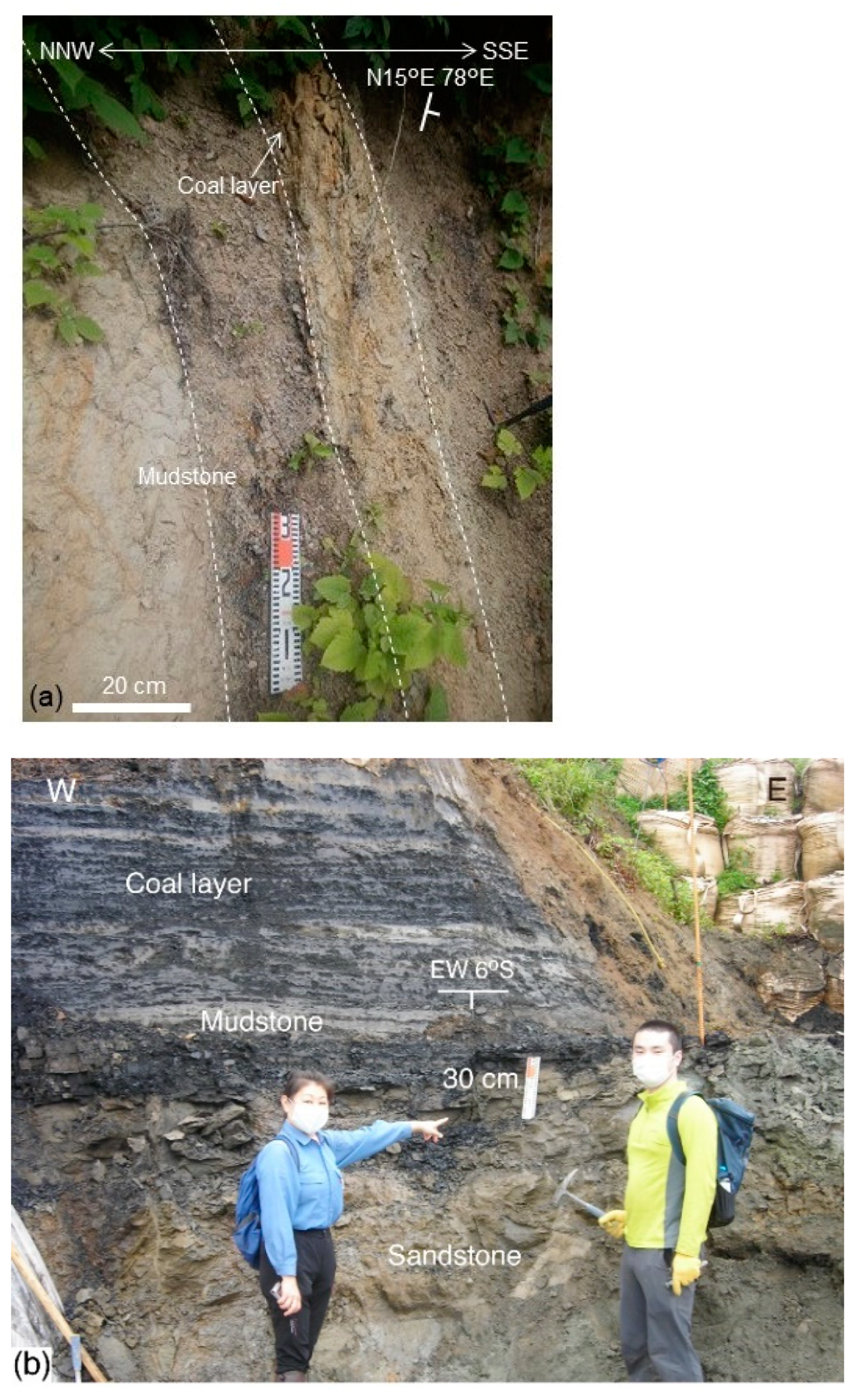
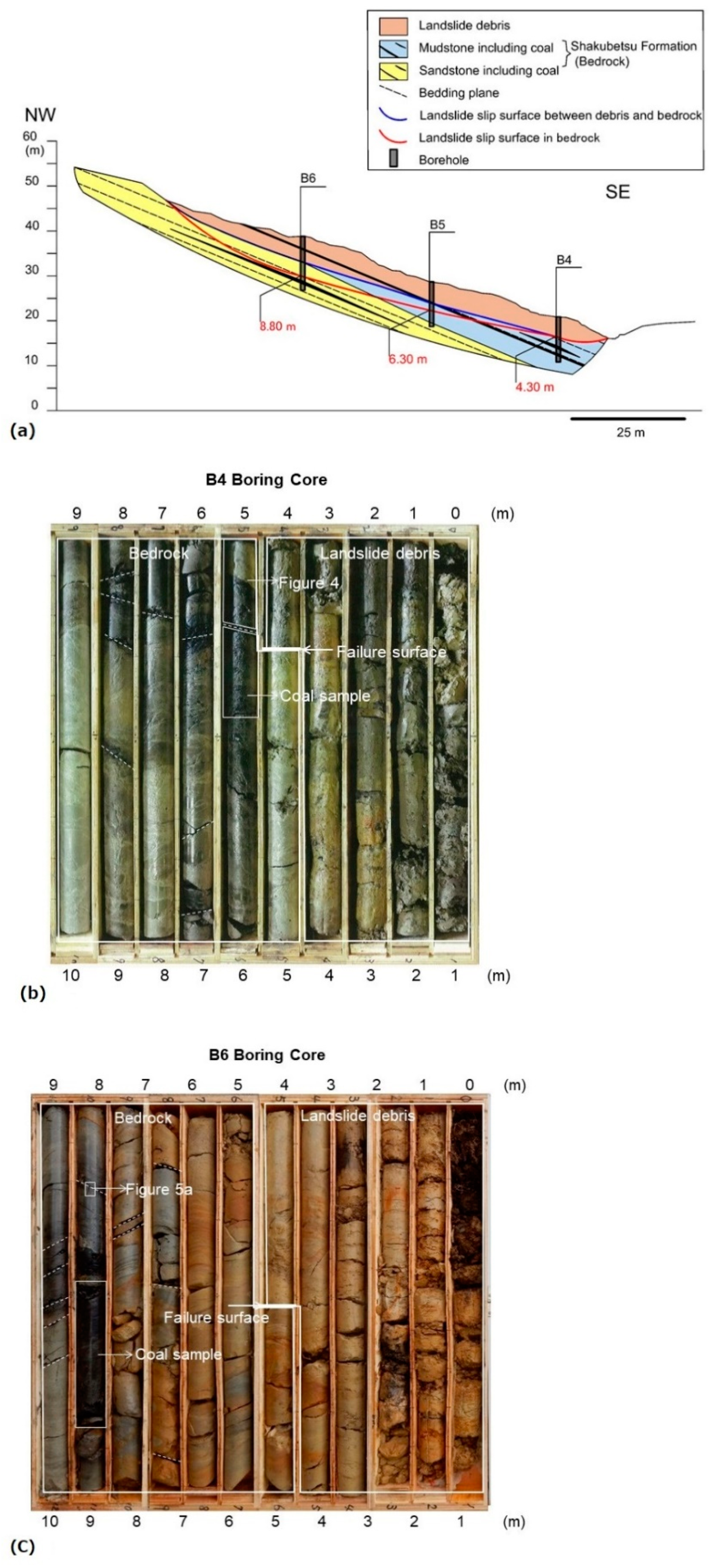
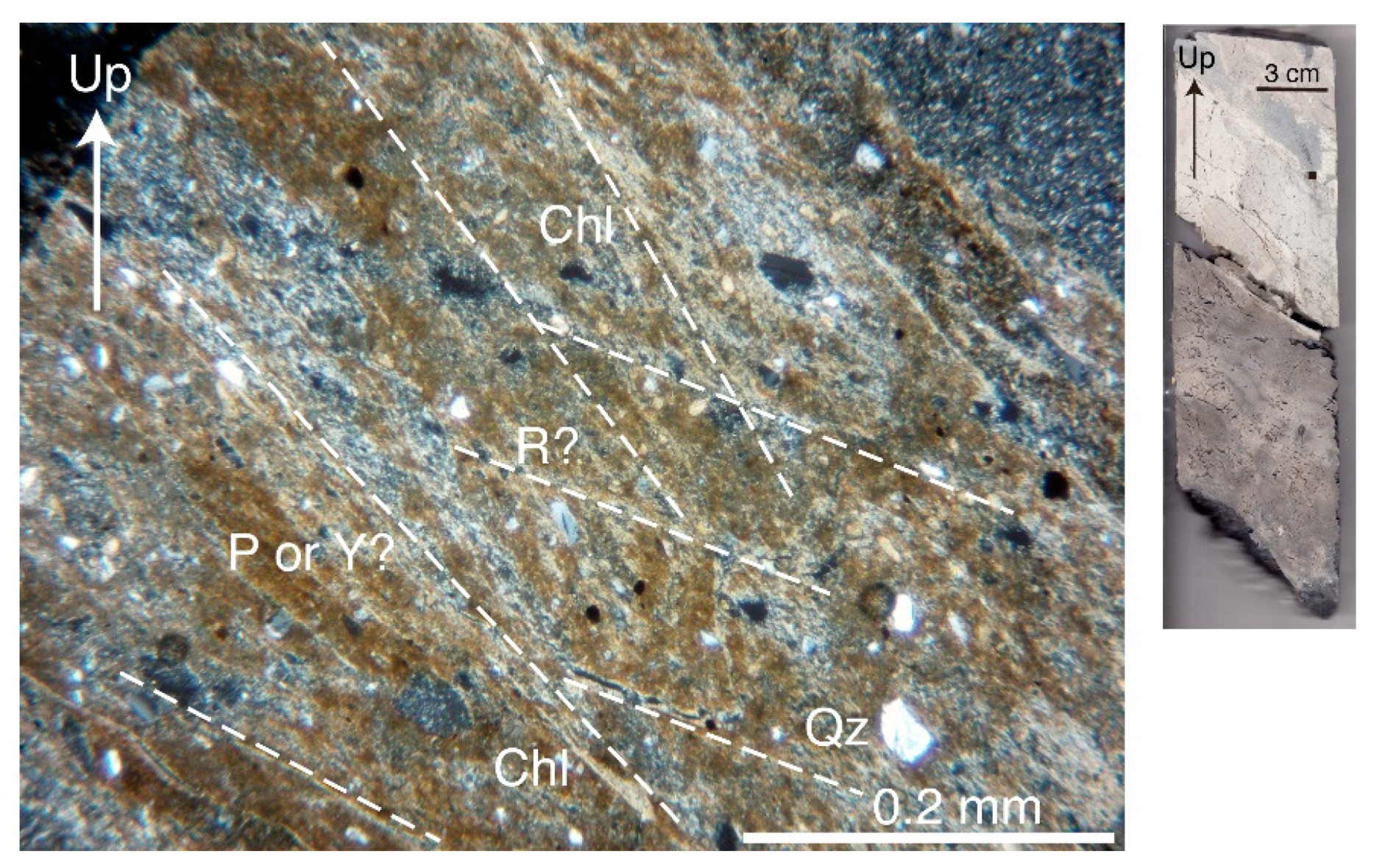


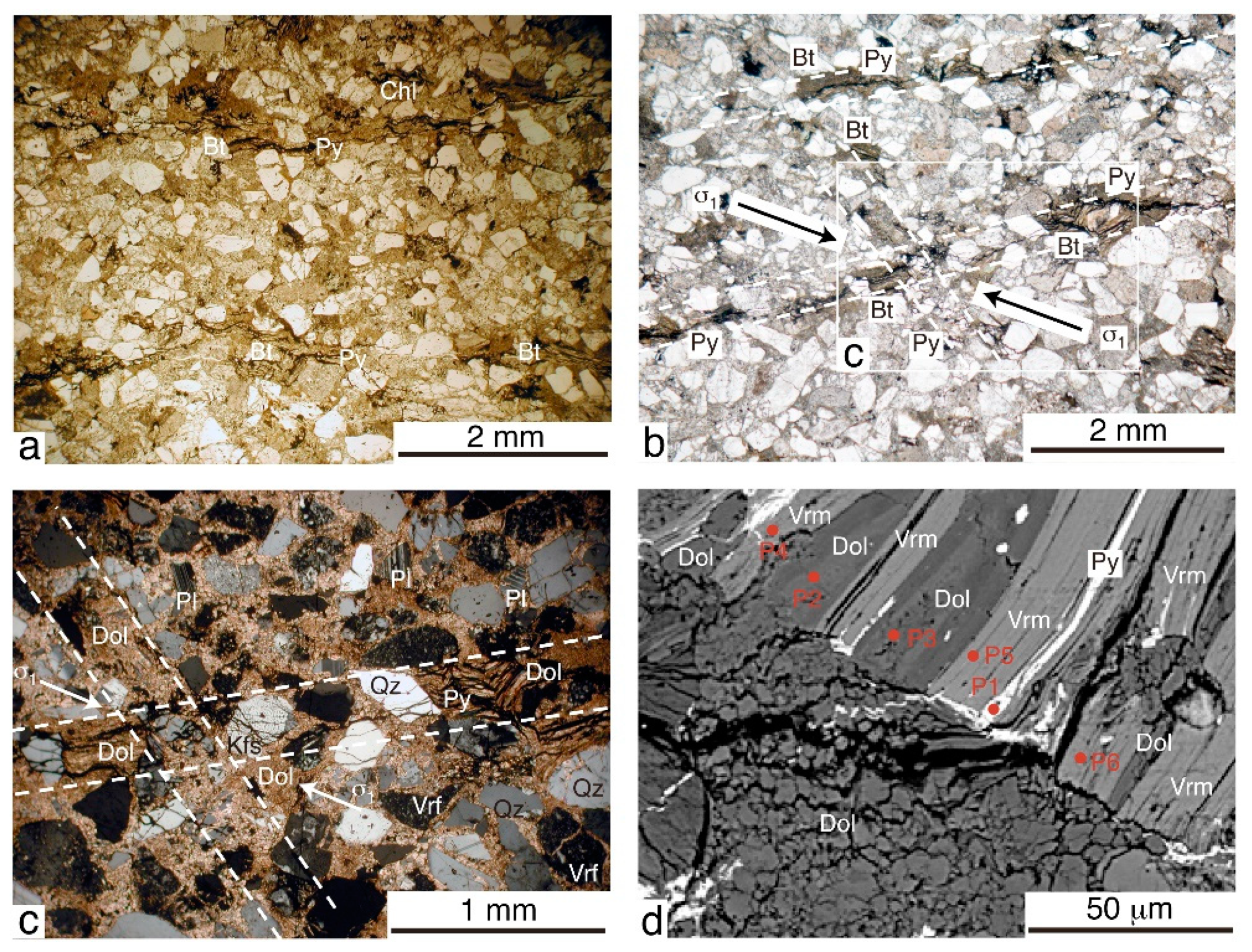

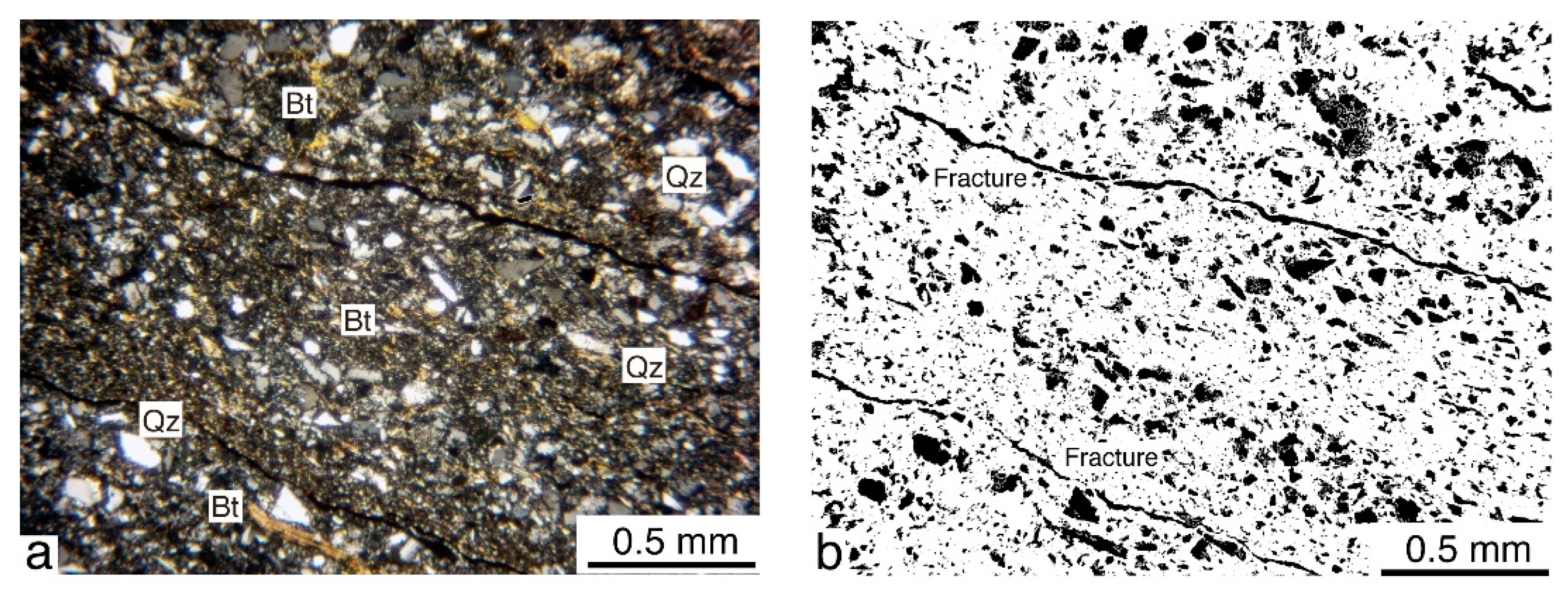

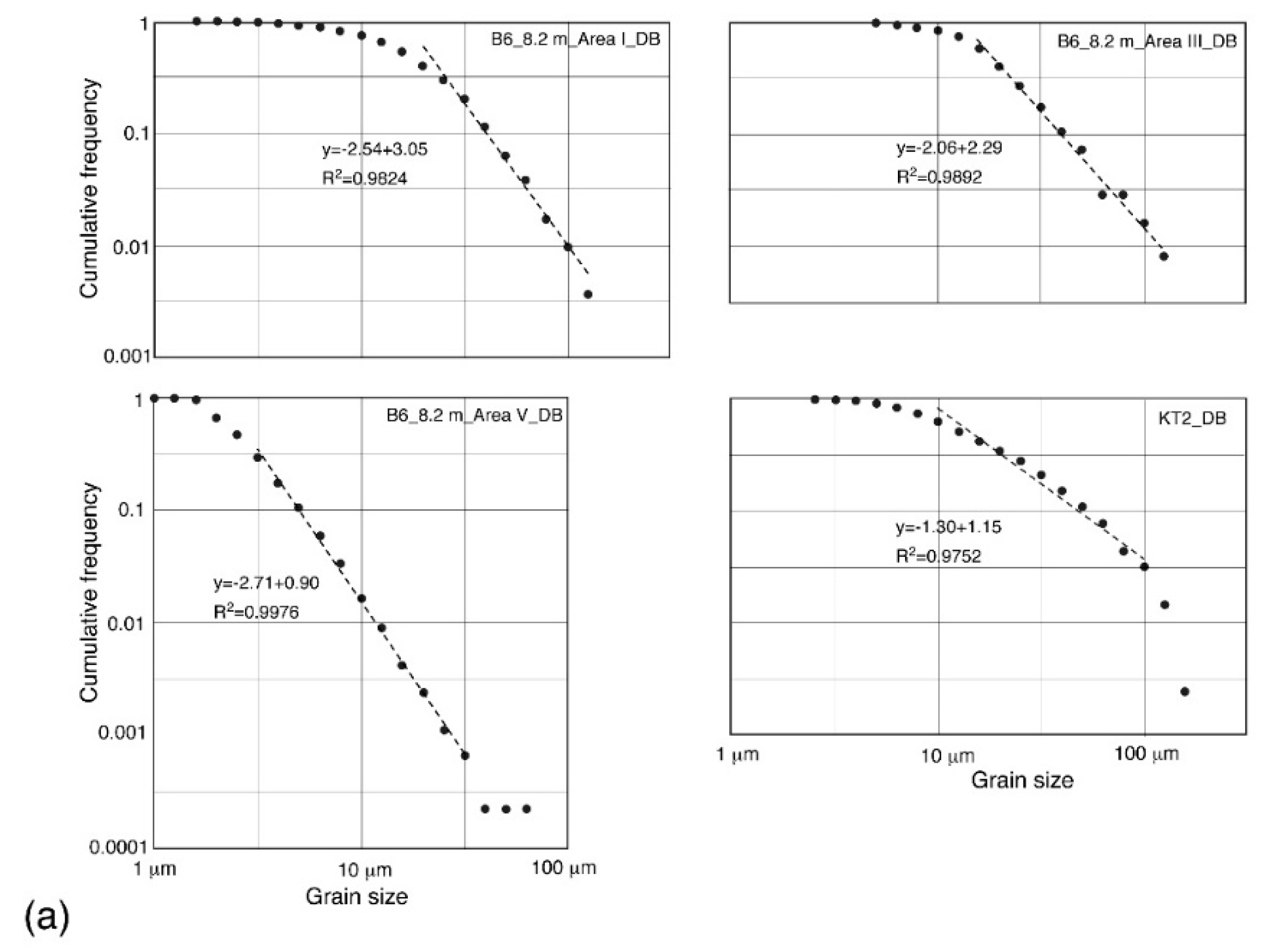
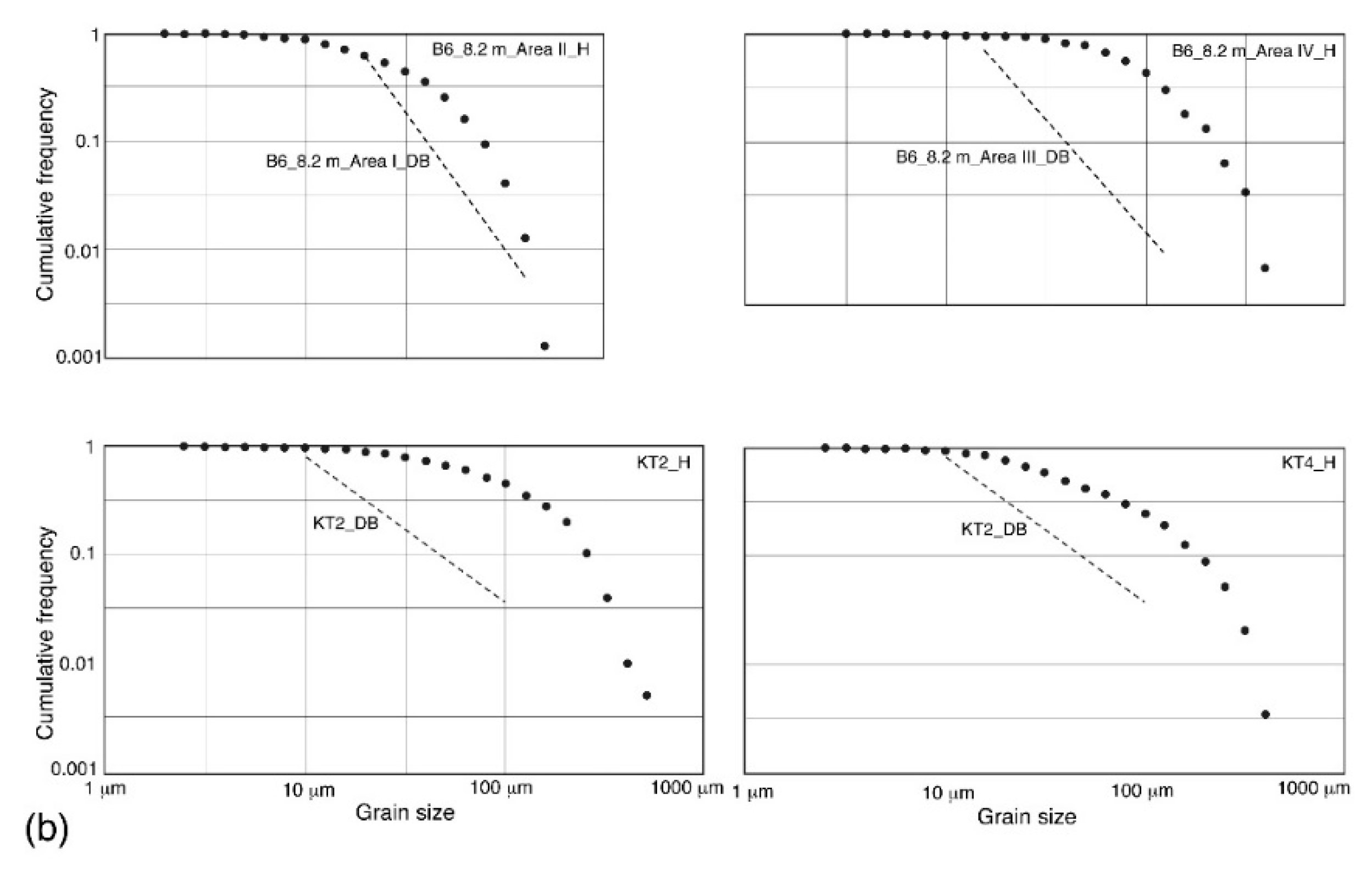
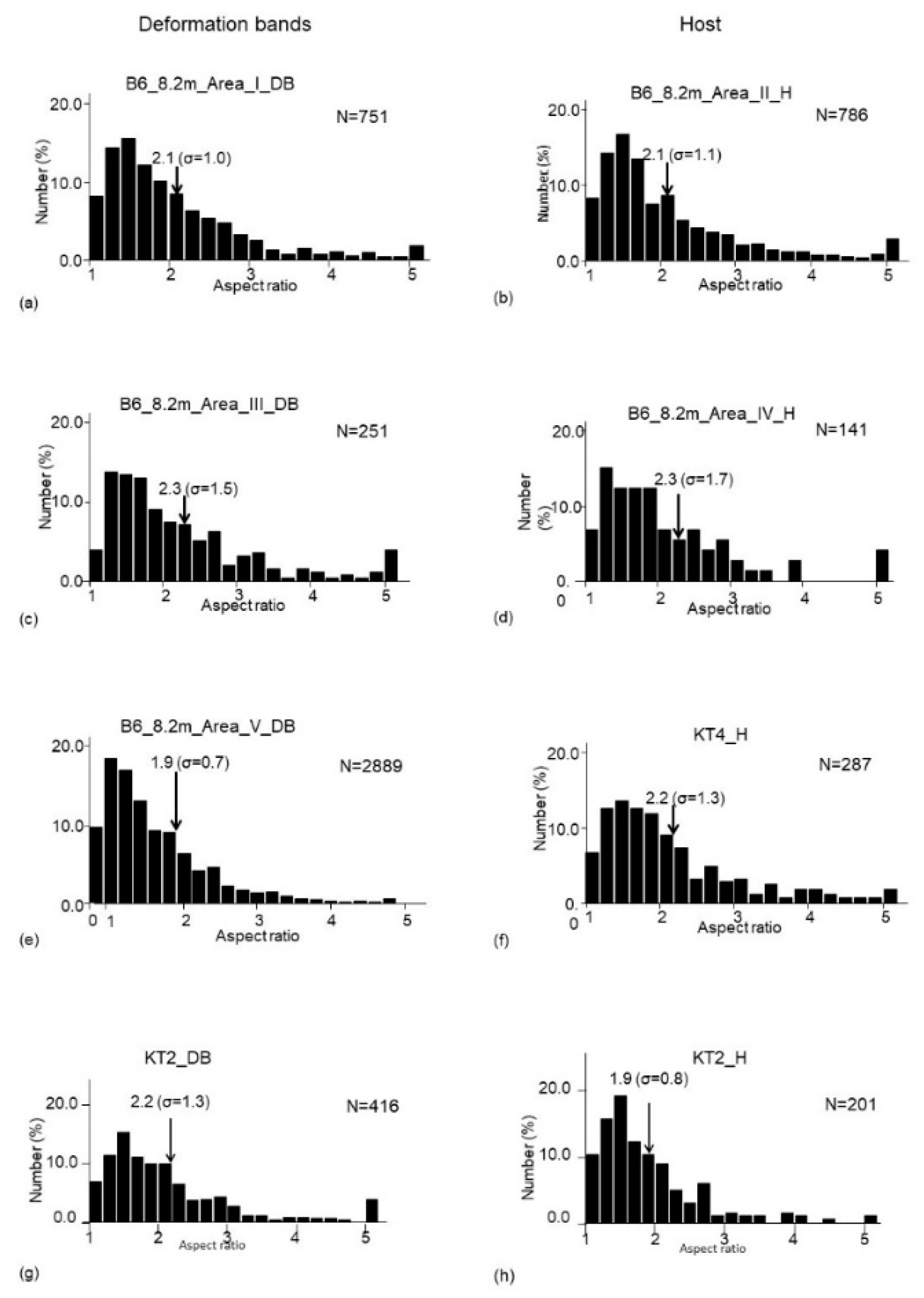
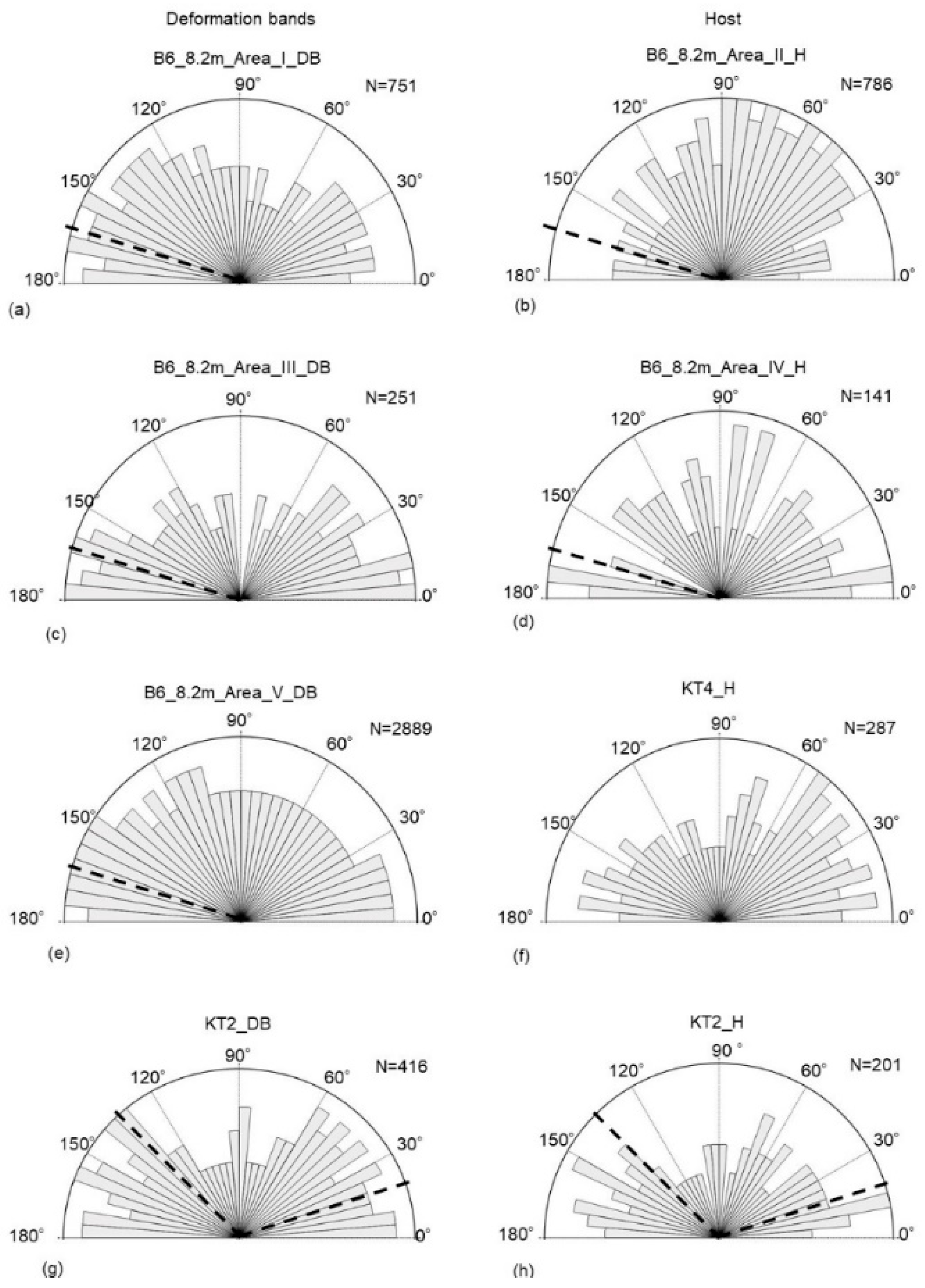
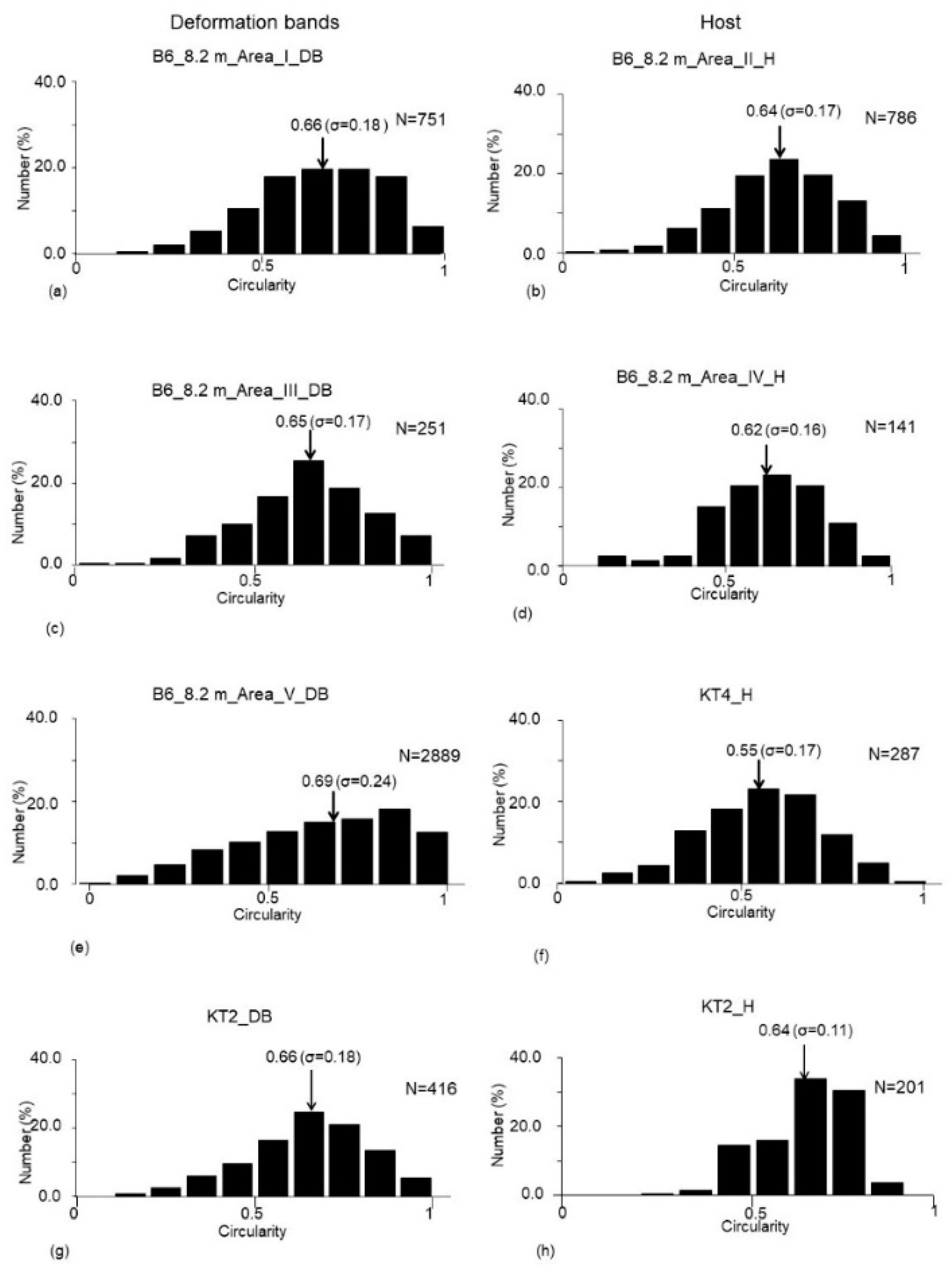
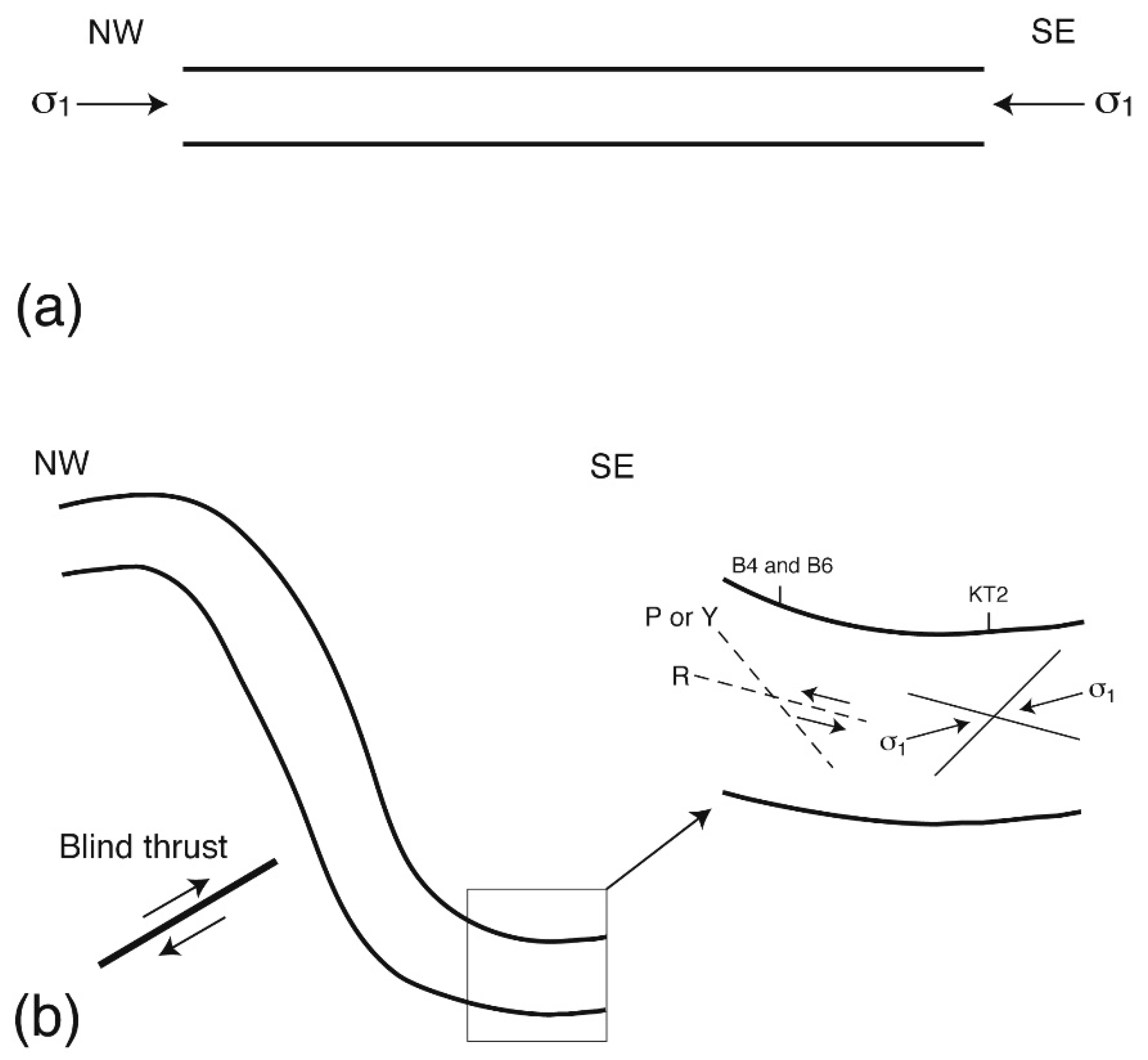
| Sample No. | Core or Outcrop Sample | Formation | Lithology | Analysis |
|---|---|---|---|---|
| B4_5.1 m | core | Shakubetsu F. | gouge | micro. |
| B4_5.3 m | core | Shakubetsu F. | coal | vitri. |
| B6_8.2 m | core | Shakubetsu F. | v.f.s. to f.s. with mudst. and coal layers | micro. image a. EPMA |
| B6_8.6 m | core | Shakubetsu F. | coal | vitri. |
| KT1 | outcrop | Shakubetsu F. | v.f.s. to f.s. | micro. SEM-EDS |
| KT2 | outcrop | Shakubetsu F. | f.s to m.s. with mudst. and coal layers | micro. SEM-EDS, EPMA, image a. |
| KT3 | outcrop | Shakubetsu F. | v.f.s. | micro. SEM-EDS, EPMA |
| KT4 | outcrop | Shitakara F. | f.s. to m.s. | image a. |
| KT5 | outcrop | Shakubetsu F. | v.f.s. with mudst. and coal layers | vitri. |
| Sample | B6_8.2 m | B6_8.2 m | KT1 | KT1 | KT1 | KT1 | KT1 | KT1 | KT2 | KT2 | KT2 | KT2 | KT2 | KT3 | KT3 | KT3 | KT3 |
|---|---|---|---|---|---|---|---|---|---|---|---|---|---|---|---|---|---|
| Band type | CB | CB | PB | PB | PB | PB | PB | PB | CB | CB | CB | CB | CB | PB | PB | PB | PB |
| Point No. | P1 | P2 | P1 | P2 | P3 | P4 | P5 | P6 | P2 | P3 | P4 | P5 | P6 | P1 | P2 | P3 | P4 |
| Mineral | Sme | Sme | Vrm * | Kln * | Sme * | Vrm * | Kln * | Sme | Dol | Dol | Vrm | Vrm | Vrm | Lm * | Chl | Chl | Kln |
| SiO2 | 45.03 | 45.41 | 40.00 | 54.02 | 63.49 | 40.49 | 54.10 | 63.49 | 0.00 | 2.75 | 31.76 | 33.49 | 37.50 | 0.00 | 33.80 | 38.16 | 47.53 |
| TiO2 | 0.05 | 0.13 | 4.36 | 0.00 | 0.00 | 4.22 | 0.00 | 0.00 | 0.04 | 0.25 | 3.29 | 3.33 | 2.60 | 0.50 | 0.06 | 0.02 | 0.13 |
| Al2O3 | 17.25 | 19.63 | 15.65 | 44.36 | 27.75 | 15.66 | 44.38 | 28.31 | 0.04 | 1.62 | 16.46 | 16.32 | 21.44 | 0.00 | 22.44 | 25.81 | 36.67 |
| Cr2O3 | 0.01 | 0.01 | 0.00 | 0.00 | 0.00 | 0.00 | 0.0 | 0.00 | 0.08 | 0.00 | 0.00 | 0.02 | 0.03 | 0.00 | 0.00 | 0.00 | 0.00 |
| NiO | 0.03 | 0.02 | - | - | - | - | - | - | 0.04 | 0.00 | 0.00 | 0.00 | 0.00 | - | 0.03 | 0.01 | 0.01 |
| FeO | 1.35 | 1.56 | 22.60 | 16.56 | 2.74 | 22.39 | 1.14 | 2.50 | 5.37 | 4.56 | 25.54 | 23.18 | 19.75 | 95.93 | 22.87 | 17.14 | 0.22 |
| MnO | 0.00 | 0.02 | 0.00 | 0.00 | 0.00 | 0.00 | 0.00 | 0.00 | 0.28 | 0.20 | 0.31 | 0.38 | 0.21 | 2.86 | 0.38 | 0.27 | 0.00 |
| MgO | 2.53 | 2.16 | 12.26 | 0.40 | 2.85 | 12.06 | 0.38 | 2.75 | 17.92 | 19.05 | 9.11 | 8.53 | 6.78 | 0.46 | 7.68 | 5.85 | 0.24 |
| CaO | 1.66 | 0.85 | 0.00 | 0.00 | 2.96 | 0.00 | 0.00 | 2.65 | 31.81 | 28.31 | 0.54 | 0.83 | 0.59 | 0.73 | 0.10 | 0.18 | 0.28 |
| Na2O | 0.06 | 0.06 | 0.00 | 0.00 | 0.21 | 0.00 | 0.00 | 0.30 | 1.96 | 7.10 | 0.09 | 0.08 | 0.08 | 0.00 | 0.07 | 0.05 | 0.00 |
| K2O | 0.79 | 0.90 | 5.14 | 0.00 | 0.00 | 5.18 | 0.00 | 0.00 | 0.00 | 0.00 | 0.74 | 2.31 | 0.54 | 0.00 | 1.12 | 0.76 | 0.60 |
| (Total) | (68.75) | (70.74) | (100 *) | (100 *) | (100 *) | (100 *) | (100 *) | (100 *) | (55.63) | (57.04) | (97.49) | (96.84) | (97.30) | (100 *) | (88.55) | (88.25) | (85.67) |
| (Oxygen) | (22) | (22) | (22) | (22) | (22) | (22) | (22) | (22) | (2) | (2) | (22) | (22) | (22) | - | (28) | (28) | (28) |
| Si | 7.75 | 7.58 | 5.69 | 6.32 | 7.51 | 5.75 | 6.32 | 7.50 | 0.00 | 0.08 | 5.22 | 5.43 | 5.70 | - | 6.80 | 7.32 | 8.25 |
| Ti | 0.01 | 0.02 | 0.47 | 0.00 | 0.00 | 0.45 | 0.00 | 0.00 | 0.00 | 0.01 | 0.41 | 0.41 | 0.30 | - | 0.01 | 0.00 | 0.02 |
| Al | 3.50 | 3.86 | 2.62 | 6.12 | 3.87 | 2.62 | 6.11 | 3.94 | 0.00 | 0.05 | 3.19 | 3.12 | 3.84 | - | 5.32 | 5.83 | 7.50 |
| Cr | 0.00 | 0.00 | 0.00 | 0.00 | 0.00 | 0.00 | 0.00 | 0.00 | 0.00 | 0.00 | 0.00 | 0.00 | 0.00 | - | 0.00 | 0.00 | 0.00 |
| Ni | 0.00 | 0.00 | - | - | - | - | - | - | 0.00 | 0.00 | 0.00 | 0.00 | 0.00 | - | 0.01 | 0.00 | 0.00 |
| Fe2+ | 0.19 | 0.22 | 2.69 | 0.12 | 0.27 | 2.66 | 0.11 | 0.25 | 0.14 | 0.11 | 3.51 | 3.14 | 2.51 | - | 3.84 | 2.75 | 0.03 |
| Mn | 0.00 | 0.00 | 0.00 | 0.00 | 0.00 | 0.00 | 0.00 | 0.00 | 0.01 | 0.00 | 0.04 | 0.05 | 0.03 | - | 0.07 | 0.04 | 0.00 |
| Mg | 0.65 | 0.54 | 2.60 | 0.07 | 0.50 | 2.55 | 0.07 | 0.48 | 0.81 | 0.79 | 2.23 | 2.06 | 1.54 | - | 2.30 | 1.67 | 0.06 |
| Ca | 0.31 | 0.15 | 0.00 | 0.00 | 0.38 | 0.00 | 0.00 | 0.33 | 1.04 | 0.85 | 0.10 | 0.14 | 0.10 | - | 0.02 | 0.02 | 0.05 |
| Na | 0.02 | 0.02 | 0.00 | 0.00 | 0.05 | 0.00 | 0.00 | 0.07 | 0.00 | 0.00 | 0.45 | 1.81 | 0.73 | - | 0.03 | 0.02 | 0.00 |
| K | 0.17 | 0.19 | 0.93 | 0.00 | 0.00 | 0.94 | 0.00 | 0.00 | 0.00 | 0.01 | 0.16 | 0.48 | 0.10 | - | 0.29 | 0.18 | 0.13 |
| (Sum) | (12.59) | (12.58) | (15.00) | (12.62) | (12.58) | (14.96) | (12.62) | (12.57) | (2.00) | (1.90) | (14.87) | (14.86) | (14.14) | - | (18.69) | (17.87) | (16.05) |
| Mg# | 77 | 71 | 49 | - | 65 | 49 | - | 66 | - | - | 39 | 40 | 38 | - | 37 | 38 | - |
| [VI]Al | 3.24 | 3.44 | 0.31 | 4.43 | 3.38 | 0.37 | 4.44 | 3.43 | - | - | 0.41 | 0.55 | 1.54 | - | 4.12 | 5.15 | 7.75 |
| [IV]Al | 0.25 | 0.42 | 2.31 | 1.68 | 0.49 | 2.25 | 1.68 | 0.50 | - | - | 2.78 | 2.57 | 2.30 | - | 1.20 | 0.68 | −0.25 |
| [A]Ca+Na+K | 0.50 | 0.36 | 0.93 | 0.00 | 0.42 | 0.94 | 0.00 | 0.40 | - | - | 0.28 | 0.65 | 0.22 | - | 0.34 | 0.24 | 0.19 |
| Sample Number | Mean of Ro% | Number of Analysis | Minimum Ro | Maximum Ro | 1σ | Calculated Temperature ± 1σ |
|---|---|---|---|---|---|---|
| B4_5.1 m | 0.50 | 65 | 0.45 | 0.55 | 0.027 | 47.3 ± 7.9 °C |
| B6_8.6 m | 0.52 | 87 | 0.46 | 0.57 | 0.033 | 47.7 ± 9.8 °C |
| KT5 | 0.50 | 95 | 0.43 | 0.57 | 0.037 | 47.3 ± 11.0 °C |
Publisher’s Note: MDPI stays neutral with regard to jurisdictional claims in published maps and institutional affiliations. |
© 2022 by the authors. Licensee MDPI, Basel, Switzerland. This article is an open access article distributed under the terms and conditions of the Creative Commons Attribution (CC BY) license (https://creativecommons.org/licenses/by/4.0/).
Share and Cite
Kaji, H.; Takeshita, T. Development of Deformation Bands and Deformation Induced Weathering in a Forearc Coal-Bearing Paleogene Fold Belt, Northern Japan. Appl. Sci. 2022, 12, 8348. https://doi.org/10.3390/app12168348
Kaji H, Takeshita T. Development of Deformation Bands and Deformation Induced Weathering in a Forearc Coal-Bearing Paleogene Fold Belt, Northern Japan. Applied Sciences. 2022; 12(16):8348. https://doi.org/10.3390/app12168348
Chicago/Turabian StyleKaji, Hiromi, and Toru Takeshita. 2022. "Development of Deformation Bands and Deformation Induced Weathering in a Forearc Coal-Bearing Paleogene Fold Belt, Northern Japan" Applied Sciences 12, no. 16: 8348. https://doi.org/10.3390/app12168348
APA StyleKaji, H., & Takeshita, T. (2022). Development of Deformation Bands and Deformation Induced Weathering in a Forearc Coal-Bearing Paleogene Fold Belt, Northern Japan. Applied Sciences, 12(16), 8348. https://doi.org/10.3390/app12168348






